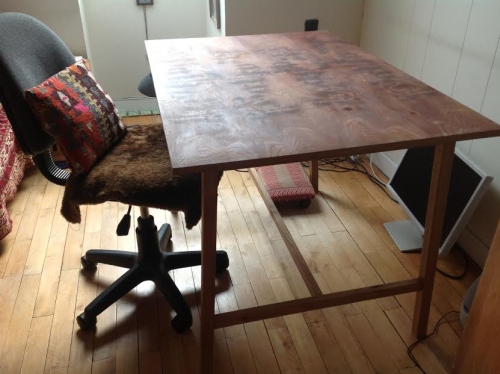 Craft apprenticeships never took hold in the United States in the way that they did in Europe. Apprenticeships existed here but even in colonial times an ever expanding country, and a constant demand for talent, meant that anyone with a modicum of skills could get a job - even if they weren't fully trained. There was little incentive for a skilled apprentice to complete their indenture, little enforcement, and a steady stream of immigrants to fill the need for trained craftsman. Craft apprenticeships never took hold in the United States in the way that they did in Europe. Apprenticeships existed here but even in colonial times an ever expanding country, and a constant demand for talent, meant that anyone with a modicum of skills could get a job - even if they weren't fully trained. There was little incentive for a skilled apprentice to complete their indenture, little enforcement, and a steady stream of immigrants to fill the need for trained craftsman.
In the United States today some forward looking companies have apprenticeship programs of one sort or another, but in general a person gets out of school with a BA or something like that and tries to get work in a good shop. Of course the shop needs them to produce, so while ideally there might be some training, most of the time it just learning production.
 In Europe, via a combination of industry support, strict rules on hiring and firing, and government aid, apprenticeship systems exist for recent school graduates. You can actually go to University to study to become a joiner and in the process of your schooling work as an apprentice in cabinetmaking shops. Unlike the old days when one would start at age fourteen, the apprenticeships are more like what in England they called "improvers". People who knew the basics and were now traveling to new shops to round out their experience and broaden their horizons. In Germany today there is even a group of journeyman who are following the strict medieval rules of journeymen and are walking from town to town, working in shops along the way. In Europe, via a combination of industry support, strict rules on hiring and firing, and government aid, apprenticeship systems exist for recent school graduates. You can actually go to University to study to become a joiner and in the process of your schooling work as an apprentice in cabinetmaking shops. Unlike the old days when one would start at age fourteen, the apprenticeships are more like what in England they called "improvers". People who knew the basics and were now traveling to new shops to round out their experience and broaden their horizons. In Germany today there is even a group of journeyman who are following the strict medieval rules of journeymen and are walking from town to town, working in shops along the way.
 Laura, a friend of ours in Copenhagen is at University training to be a joiner. In Denmark when they train a joiner they mean it. She has mastered both traditional skills and modern machinery so as to be fully ready for the twenty-first century. Her training, and frankly the training of a lot of joiners in Europe, is the reason why you can still buy well made, well designed furniture in Europe that reflects a great combination of modern machinery and hand skill. Laura, a friend of ours in Copenhagen is at University training to be a joiner. In Denmark when they train a joiner they mean it. She has mastered both traditional skills and modern machinery so as to be fully ready for the twenty-first century. Her training, and frankly the training of a lot of joiners in Europe, is the reason why you can still buy well made, well designed furniture in Europe that reflects a great combination of modern machinery and hand skill.
runn
Summer is coming and Laura is looking for an apprenticeship position in the United States running from May through August. The apprenticeship is mostly paid by her school but in addition the shop must contribute $585 per month to her expenses.
Currently she is working at www.rudrasmussen.com, a 140 year old Furniture workshop in Copenhagen that designs and produces hand crafted wooden furniture.
Laura is a capable hand, and machine woodworker - in her spare time she makes- you guessed it - furniture.
If you run a professional woodworking shop - in any discipline - furniture, cabinetry, etc. - and you would like to host Laura, please email us and we will forward your information to Laura so she can contact you directly. She speaks English so don't worry about communication. Please include the name of your shop or a link to your website.
This is a great opportunity for the right shop, and for Laura. You get skilled labor - and she gets hands on experience.
Note: The work in the pictures are all pieces done by Laura.
In other news: The Joiner and Cabinetmaker, is back in print. The only contemporary narrative training course from the pre-machine tool age this book, originally published in 1839, tells the story of how Thomas was trained as a joiner. Complete with projects, instructions, and a villain. Originally published 1n 1839, with historical commentary by me. All three projects in the book were build by Chris Schwarz. If you don't already have a copy, you can get one here! |
 Joel's Blog
Joel's Blog Built-It Blog
Built-It Blog Video Roundup
Video Roundup Classes & Events
Classes & Events Work Magazine
Work Magazine


 Craft apprenticeships never took hold in the United States in the way that they did in Europe. Apprenticeships existed here but even in colonial times an ever expanding country, and a constant demand for talent, meant that anyone with a modicum of skills could get a job - even if they weren't fully trained. There was little incentive for a skilled apprentice to complete their indenture, little enforcement, and a steady stream of immigrants to fill the need for trained craftsman.
Craft apprenticeships never took hold in the United States in the way that they did in Europe. Apprenticeships existed here but even in colonial times an ever expanding country, and a constant demand for talent, meant that anyone with a modicum of skills could get a job - even if they weren't fully trained. There was little incentive for a skilled apprentice to complete their indenture, little enforcement, and a steady stream of immigrants to fill the need for trained craftsman. In Europe, via a combination of industry support, strict rules on hiring and firing, and government aid, apprenticeship systems exist for recent school graduates. You can actually go to University to study to become a joiner and in the process of your schooling work as an apprentice in cabinetmaking shops. Unlike the old days when one would start at age fourteen, the apprenticeships are more like what in England they called "improvers". People who knew the basics and were now traveling to new shops to round out their experience and broaden their horizons. In Germany today there is even a group of journeyman who are following the strict medieval rules of journeymen and are walking from town to town, working in shops along the way.
In Europe, via a combination of industry support, strict rules on hiring and firing, and government aid, apprenticeship systems exist for recent school graduates. You can actually go to University to study to become a joiner and in the process of your schooling work as an apprentice in cabinetmaking shops. Unlike the old days when one would start at age fourteen, the apprenticeships are more like what in England they called "improvers". People who knew the basics and were now traveling to new shops to round out their experience and broaden their horizons. In Germany today there is even a group of journeyman who are following the strict medieval rules of journeymen and are walking from town to town, working in shops along the way.  Laura, a friend of ours in Copenhagen is at University training to be a joiner. In Denmark when they train a joiner they mean it. She has mastered both traditional skills and modern machinery so as to be fully ready for the twenty-first century. Her training, and frankly the training of a lot of joiners in Europe, is the reason why you can still buy well made, well designed furniture in Europe that reflects a great combination of modern machinery and hand skill.
Laura, a friend of ours in Copenhagen is at University training to be a joiner. In Denmark when they train a joiner they mean it. She has mastered both traditional skills and modern machinery so as to be fully ready for the twenty-first century. Her training, and frankly the training of a lot of joiners in Europe, is the reason why you can still buy well made, well designed furniture in Europe that reflects a great combination of modern machinery and hand skill.
Thanks for posting Joel
Don't be fooled by brand name factories which have an "handmade or custom made shop" department for special orders. They are hybrid handmade/factory made and are still products far below what a truly handmade guitar will yield. To find a great guitar, find a great luthier, the smaller the shop, generally the better.
It would be wonderful to see woodworking and woodworkers in general return to those roots, everywhere. You don't have to do it for living to keep the art alive. You just have to love it and be willing to research and work to recover the lost arts, which in fact can usually be found somewhere alive and well in the world or even on your home continent, maybe closer than you imagine.
Steven
To answer the questions of Davids comment:
Rud. Rasmussen was bought by a company called Carl Hansen in 2011.
Carl Hansen has several factories, all producing high quality Danish
design furnitures (but not all as old school as Rud. Rasmussen).
Rud. Rasmussen is not a very profitable business, because the amount
of hours put into one piece of furniture is so high, that the
furniture becomes very expensive and therefore hard to sell in large
numbers.
But Rud. Rasmussen is so well known in both Denmark and around the
world, that there is a demand for the furnitures. And almost every
home of Danes above 60 years has at least one piece of furniture from
Rud. Rasmussen.
But that said Rud. Rasmussen is now owned by Carl Hansen because it
was too hard to run after the financial crisis. Carl Hansen has an
interest in preserving the Rud. Rasmussen workshop. Both because they
need the traditions and carftsmen to make some of the specific
furnitures, but also because they want to show costumers and business
relations how traditional Danish craftmanship is done. It is sort of
their crowning glory.
And for the other questions he asked:
In Denmark everybody rides their bikes everywhere, no matter how the
weather is - that is just how Danes gets around :)
We are around 20 joiners hired in the workshop. The others had work to
do the day the filmcrew came around.
Cheers,
Laura